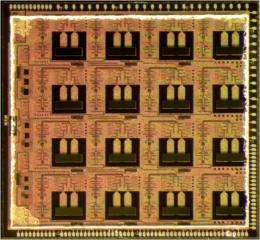Researchers develop first silicon wafer-scale 110 GHz phased array transmitter

(PhysOrg.com) -- TowerJazz, the global specialty foundry leader, and The University of California, San Diego, provider of a leading program in microwave, millimeter-wave and mixed-signal RFICs, today announced they have demonstrated the first wafer-scale phased array with 16 different antenna elements operating at 110 GHz frequency range. First time success was achieved for the RFIC using TowerJazz’s own proprietary models, kit and the mmWave capabilities of its 0.18-micron SiGe BiCMOS process, SBC18H3. The device targets applications for automotive radar, aerospace and defense, passive imaging, security, and mmWave imaging. The collaboration of the phased array chip was partly funded by DARPA.
The wafer-scale SiGe BiCMOS chip is 6.5x6.0mm and combines the 110 GHz source, amplifiers, distribution network, phase shifters and high-efficiency on-chip antennas, allowing a new generation of miniature and low-cost phased arrays for W-band (75-110 GHz) applications. Such an advancement better serves the needs of the greater than $100M emerging markets of auto radar and passive imaging (security). The antennas are integrated on-chip which removes the expensive and lossy transitions and distribution network between the phased array and the off-chip elements. This wafer-scale phased array with 16 radiating elements, together with all the necessary CMOS control circuits, is capable of electronic beam scanning to +/-40 degrees in all planes. The architecture could be scaled to 64 elements (8x8) or 256 elements (16x16) due to on-chip antenna integration and the single chip integration of multiple elements.
By developing this wafer-scale chip, UCSD has successfully demonstrated independent amplitude and phase control at 106-114 GHz for all 16 different antenna elements, and provides commercial availability of highly scalable (from 16 elements to 256 elements) RF-IC transmitters for W-Band and D-Band phased array applications. The chip was designed and tested by Woorim Shin, Ozgur Inac, and Bonhyun Ku, all from the Electrical and Computer Engineering Department at UCSD under the supervision of Prof. Gabriel M. Rebeiz, and was partially sponsored by the DARPA GRATE program under the direction of Dr. Carl McCants. The work was done under a subcontract to UCSD from TowerJazz.
The phased array chip was developed using TowerJazz’s SBC18H3 BiCMOS which offers both high-performance 0.18-micron SiGe bipolar and high quality passive elements combined with high density 0.18-micron CMOS, to enable high-speed networking and millimeter wave applications. The process offers SiGe transistors with peak Fmax of 280GHz and peak Ft of 240GHz, ideal for low-power, high performance millimeter wave circuits, while replacing the need for more expensive GaAs chips. SBC18H3 comes standard with 1.8 and 3.3 volt CMOS (dual-gate), deep trench isolation, lateral and vertical PNP transistors, MIM capacitors, high-performance varactors, poly-silicon as well as metal and N-well resistors, p-i-n and Schottky diodes, high-Q inductors, triple well isolation, and six layers of metal.
“This is yet another advancement in the area of phased arrays that we are proud to announce. We have a track record of successful collaboration with TowerJazz and the ability to bring this innovative design from UCSD to market depends strongly on TowerJazz’s SiGe BiCMOS process which enables lower-cost phased arrays by integrating many functions and high efficiency antennas on the same silicon chip,” said Dr. Gabriel M. Rebeiz, Professor of Electrical Engineering at UCSD, the lead professor on this chip.
"We believe the results achieved by UCSD’s phased array transmitter demonstrates the remarkable teamwork between TowerJazz, UCSD and DARPA to provide novel capabilities and technologies to both the aerospace and defense community as well as commercial markets,” said Dr. David Howard, TowerJazz’s Executive Director and Principal Investigator for DARPA GRATE Program. “TowerJazz enjoys the long term, very productive working relationship we have with Dr. Rebeiz, one of the top RF research professors in the world.”
Phased Arrays
Phased arrays allow the electronic steering of an antenna beam in any direction and with high antenna gain by controlling the phase at each antenna element. The radiation beam can be “moved in space” using entirely electronic means through control of the phase and amplitude at each antenna element used to generate the beam. This beam steering technique is much more compact and much faster than mechanically steered arrays. Furthermore, phased arrays allow the creation of deep nulls in the radiation pattern to mitigate strong interference signals from several different directions. They have been in use since the 1950’s in defense applications and have seen limited use in commercial system due to their relatively high cost. UCSD’s design and utilization of TowerJazz existing wafer processes are targeted to greatly reduce the cost of phased arrays especially at millimeter-wave frequencies.
More information: The SBC18H3 process is available through the TowerJazz multi-project wafer (MPW) system www.towerjazz.com . The chip is available from UCSD and interested parties should contact Prof. Gabriel M. Rebeiz; Department of Electrical and Computing Engineering at UCSD, 858/534-8001 or rebeiz@ece.ucsd.edu.
Provided by University of California - San Diego



















